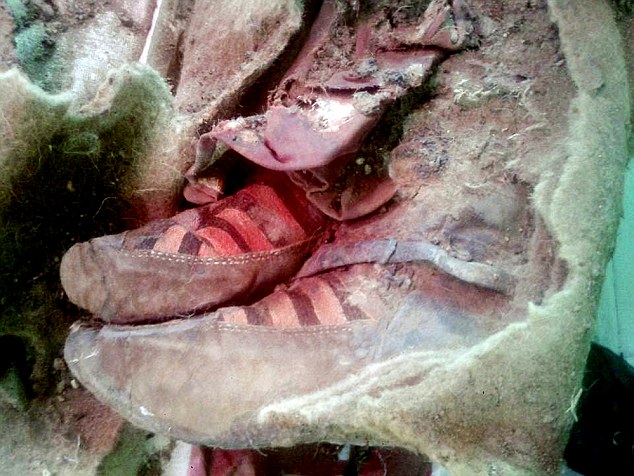Archaeologists in Mongolia are slowly unwrapping the mummy of a suspected ancient woman found preserved in the Altai Mountains.
So far only one hand and her feet in modern-looking boots are visible, but experts believe the find dates to around 1,500 years ago.
It also appears to be the first complete Turkic burial in Central Asia and the remains were found at an alтιтude of 9,200ft (2,803 metres).

Archaeologists in Mongolia are slowly unwrapping the mummy of a suspected ancient woman found preserved in the Altai Mountains. So far only one hand and her feet in modern-looking boots (pictured) are visible, but experts believe the find dates to around 1,500 years ago
Researcher B.Sukhbaatar, from Khovd Museum, said: ‘This person was not from the elite, and we believe it was likely a woman, because there is no bow in the tomb.
‘Now we are carefully unwrapping the body, and once this is complete the specialists will be able to say more precisely about the gender.’
A host of possessions were found in the grave, offering a unique insight into life in Mongolia in around the 6th century AD.
These included a saddle, bridle, clay vase, wooden bowl, trough, iron kettle, the remains of an entire horse, and ancient clothing.
There were also pillows, a sheep’s head and felt travel bag in which were placed the whole back of a sheep, goat bones and small leather bag designed to carry a cup.
The first Turkic people occupied a region from Central Asia to Siberia from the 6th century BC.
The first mention of Turks was in a Chinese text that made reference to Turk tribes and Sogdians along the Silk Road.
The Turkic people developed their own alphabets, had their own language and are known for a number of symbols including wolves and the colour blue.
In fact, some reports claim the word Turquoise originates from the word Turkish.
Today, modern Turks live across Asia and eastern Europe.
In 2003, DNA analysis revealed skeletons found in a 2,000-year-old tomb contained genes found in modern Turks.
Two years ago, archaeologists found what they believed to be the grave of a Turkic warrior also in the Altai Mountains.
Turks were buried with treasured possessions, known as ‘grave goods’ that they could take to the next world.
In this 2014 discovery, what appeared to be a Turkic warrior was buried with a musical instrument, alongside his horse.
It was not considered a complete burial due to the lack of other grave goods.
Commenting on the recent discovery, B.Sukhbaatar continued: ‘It is the first complete Turkic burial at least in Mongolia – and probably in all Central Asia.
‘This is a very rare phenomenon. These finds show us the beliefs and rituals of Turkics.



‘We can see clearly that the horse was deliberately sacrificed. It was a mare, between four and eight years old.
‘Four coats we found were made of cotton.
‘An interesting thing we found is that not only sheep wool was used, but also camel wool. We can date the burial by the things we have found there, also the type of hat.
‘It gives us a preliminary date of around the 6th century AD.’
Archaeologists from the city museum in Khovd were alerted to the burial site by local herdsmen, reported The Siberian Times.




The find will help form a deeper understanding of the native Turkic people in ancient Mongolia.’
The grave was located 9,200 feet (2,803 meters) above sea level. This fact and the cool temperatures helped to preserve the grave, which sat three metres deep.
‘The finds show us that these people were very skilled craftsmen,’ added the researcher.
‘Given that this was the grave of a simple person, we understand that craft skills were rather well developed.’
The Altai Mountains unite Siberia, in Russia, and Mongolia, China and Kazakhstan.





